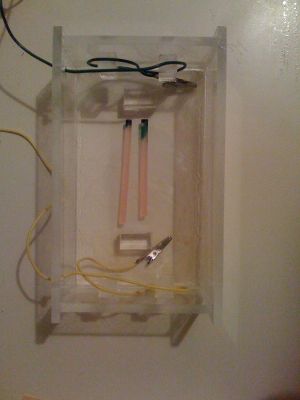DIYbio:Notebook/Keiki Gels
Gel electrophoresis is used to separate DNA or RNA molecules by size. For this experiment, the gel is inside a plastic drinking straw.
Since this is a DIYbio experiment, I emphasize that all of the materials came from regular shops, including Radioshack and an Asian grocery store in Sacramento, CA. This experiment is designed to create a faster and smaller alternative to traditional gel electrophoresis.
At this point, these instructions are for imaging food coloring - take these instructions and figure out how to do DNA, RNA, proteins, and genome fingerprinting. Staining DNA requires more than food coloring, you'll probably need a blue transilluminator, but that can be as simple as putting together a few LEDs. Would be cool to see this used with real DNA.
Better ideas? Edit this page or email: tito at titojankowski.com

General Procedure
- Cast a gel in a straw
- Load sample
- Place straw in gel box with running buffer
- Run the gel
Casting Gels
Making Gel:
- Measure 1/2 cup of water into a microwaveable glass cup
- Add 1 tbsp of agar powder into the cup. Stir.
- Microwave for 1 minute. Caution: The water may be extremely hot. If the water still has visible agar powder floating in it, swirl and microwave for 15 second intervals until the powder is totally dissolved.
How to get the gel into the straws:
- Cut clear drinking straws to 3 inch sections - each section will hold one sample
- Lay the straws at the bottom of a small bowl.
- When the cup of agar is cool enough to pick up, pour the gel into the small bowl.
- Put a heavy piece of plastic across the top of the straws so that they don't float to the top of the gel. At this point, check that the straws look like they are full of gel and don't have any air bubbles.
- Wait for the gel to harden, pull your straws out of the gel.
Buffer
- Measure 1 cup of warm water into a glass cup
- Add a pinch of salt
- Stir and microwave the water until the salt dissolves
Loading your sample
- At this point, your straws are filled with gel.
- I used a small knife to poke a hole in the straw about 1/2" from one end of the straw. This created a little pocket in the gel, which is where I added a drop of food coloring. (I used 4 straws, 1 for each of the dyes Green, Red, Blue, Yellow)
- Place the straws in parallel at the bottom of your gel electrophoresis box (or a tupperware container or bowl should be fine). The dye ends should all be facing one direction.
- Put a heavy piece of plastic across the the top of the straws so they won't float when you add buffer
Connect your power supply

#Connect 4 9v batteries in series. I used 4 because that's how many came in the pack from RadioShack ($10)
- Connect an alligator wire to the positive terminal, and another alligator wire to the negative terminal.
- Place the alligator wire connected to the positive (+) terminal in the buffer on the side of the straws with NO dye
- Place the negative (-) terminal at the end with the dye
Run the gel
- Add your buffer. It should cover the straws completely, as well as the alligator clips.
- The negative (-) alligator clip immersed in buffer will begin to have bubbles form on its surface.
- Wait about an hour, depending on how strong your power supply is. You can watch your food coloring separate into its raw colors during this time.
- Take your straws out of the gel chamber - all the colors should be separated
- Blue: becomes blue + red
- Green: becomes blue + yellow
- Yellow: yellow, but disappears quickly
- Red: red
See also
External links
- Wikipedia entry on agarose gel electrophoresis
- Utah gel box [1]
- Original post on TitoJankowski.com: http://titojankowski.com/?p=152